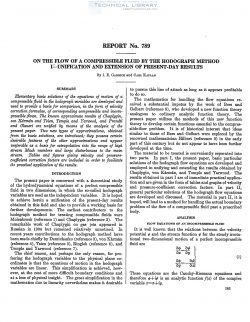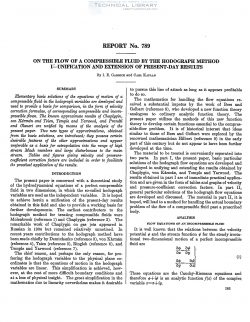naca-report-789

- Version
- 184 Downloads
- 1.68 MB File Size
- 1 File Count
- August 30, 2016 Create Date
- August 30, 2016 Last Updated
National Advisory Committee for Aeronautics, Report - On the Flow of a Compressible Fluid by the Hodograph Method, I - Unification and Extension of Present Day Results

Elementary basic solutions of the equations of motion of a
compressible fluid in the hodograph variables are developed and
used to provide a basis for comparison, in the form of velocity
correction formulas, of corresponding compressible and incom-
pressible flows. The known approximate results of Chaplygin,
con Karmdn and Tsien, Temple and Yarwood, and Prandtl
and G’lauert are unified by means of the analysis of the
present paper. Two new types of approximations, obtained
from the basic solutions, are introduced; they possess certain
desirable features of the other approximations and appear
preferable as a basis for extrapolation into the range of high
stream Mach numbers and large disturbances to the main
stream. Tables and figures giving velocity and pressure-
coqflicient correction factors are included in order to facilitate
the practical application of the results.
The present paper is concerned with a theoretical study
of the hydrodynamical equations of a perfect compressible
fluid in two dimensions, in which the so-called hodograph
variables are used as the independent variables. It is hoped
to achieve herein a unification of the present-day results
obtained in this field and also to provide a working basis for
further developments. The earliest contributors to the
hodograph method for treating compressible fluids were
Molenbroek (reference 1) and Chaplygin (reference 2). The
remarkable work of Chaplygin on gas jets appeared in
Russian in 1904 but remained relatively unnoticed. In
recent years contributions to the hodograph method have
been made chiefly by Demtchenko (reference 3), von Karman
(reference 4), Tsien (reference 5), Ringleb (reference 6), and
Temple and Yarwood (reference 7).
The chief reason, and perhaps the only reason, for pre-
ferring the hodograph variables to the physical plane co-
ordinates is that the equations of motion in the hodograph
variables are linear. This simplification is achieved, how—
ever, at the cost of more difficult boundary conditions and
at a loss of physical insight.
| File | Action |
|---|---|
| naca-report-789 On the Flow of a Compressible Fluid by the Hodograph Method, I - Unification and Extension of Present Day Results.pdf | Download |

Comment On This Post